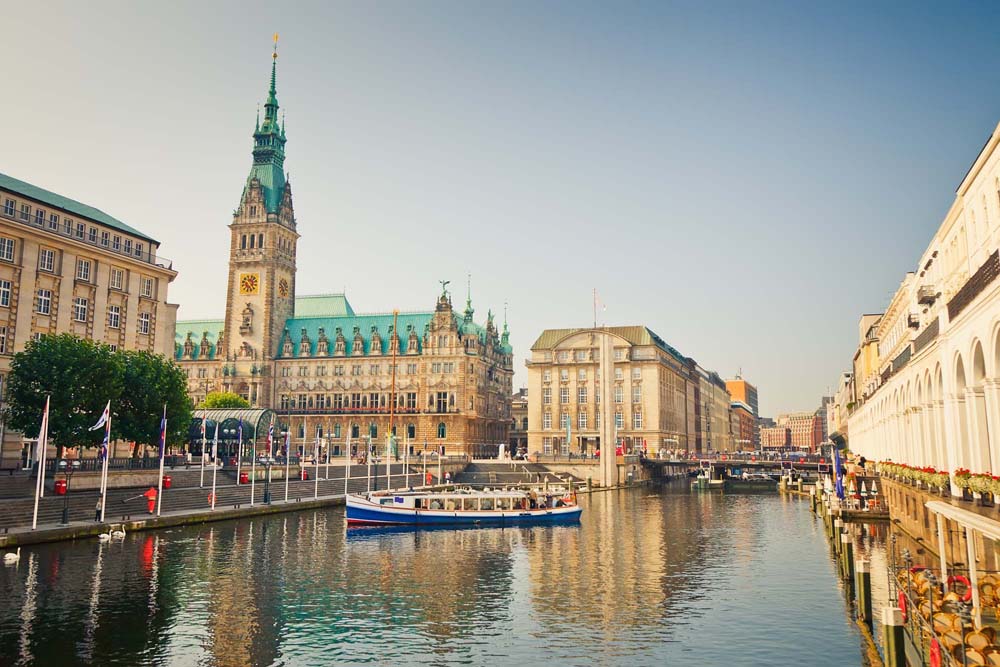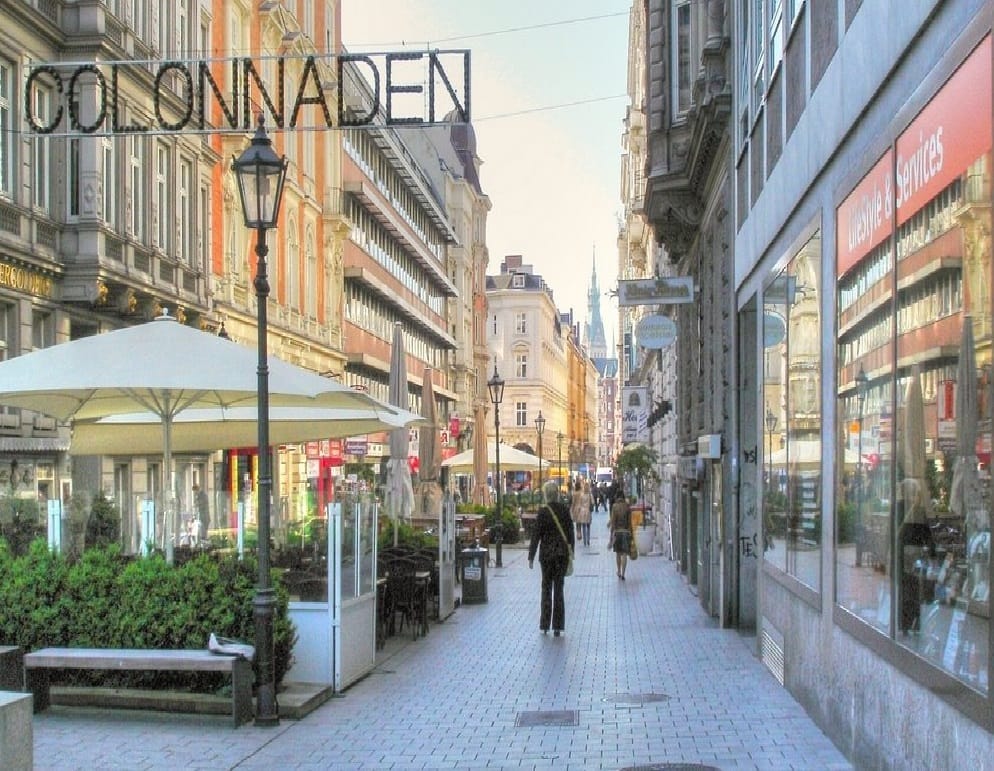Overview
Seated on the River Elbe between the North and Baltic seas, Hamburg is proud of its medieval history as a Free City and a key member of the Hanseatic League. The city was an important port of departure for immigrants to the New World, and its trade routes still stretch across the globe. Hamburg is, and always has been, a worldly, cosmopolitan, and diverse city with much to offer to its citizens and guests.
Why study German in Hamburg?
Hamburg is Germany’s Top Cultural Destination
The opening of the extravagant Elbphilharmonie concert hall in January 2017 has put Hamburg in the spotlight as the current must-see destination for music lovers worldwide. Hamburg also has over 50 museums, 45 theatres, and around 100 music venues and clubs. It’s one of the biggest musical cities in the world, second only to New York and London.
Hamburg is Built on Water
Not only is Hamburg close to two seas, it also has three rivers – Elbe, Alster, and Bille – as well as numerous waterways and canals. Students will enjoy the North Sea winds on the gorgeous Elbe and see for temselves why Hamburg is called the ‘Venice of the North’. But be warned, this lovely description is not entirely accurate: Hamburg has six times as many bridges as Venice, more than any other city in the world.
The Center of Hamburg
Hamburg has a single-core, heart-of-the-city downtown. Wrapped around picturesque Lake Alster, Hamburg’s city centre is a home to countless architectural gems and a bustling shopping district wrapped into one. Here students can stroll through shopping arcades, admire the City Hall, stop for a coffee and cake with a view, or take a canal boat tour to see sailing boats and lavish villas along the Alster’s shore.
Hamburg is a Shopper’s Paradise
Hamburg is Germany’s wealthiest city and the perfect place for some shopping. From shopping centres to small handicraft stores, luxury brands to flea markets, in Hamburg students will find something for every taste and budget.
Hamburg’s Food Comes Straight from the Source
Hamburg’s close proximity to rivers and the sea always ensures a supply of fresh fish and seafood. The Altes Land orchards south of the city comprise the largest fruit-growing region in Central Europe. Furthermore, Hamburg has centuries of experience handling luxury wares such as coffee, tea, and exotic spices straight from the ship. Fresh Hamburg cuisine can be sampled in one of the city’s high quality restaurants.
Hamburg’s Nightlife
The countless bars, clubs, and discos along the Reeperbahn – Europe’s longest party street, and a world-famous red-light district – and its surrounding streets and squares truly come alive after midnight. The party won’t stop before the sun comes up, and maybe not even then.
Hamburg’s Ease of Transportation
Hamburg’s efficient network of metro lines, buses, and ferries will ensure students get to their destination in less than half in hour, be it the airport, museums or clubs, shopping malls or nature reserves in the city’s outskirts. The city centre and harbour areas are easily covered by foot, but they can always hop on a red city bike – the first half hour is free.
Hamburg is a Green City
Hamburg is proud of its large parks, recreational areas, and the presence of nature. Just a short walk from the City Hall, the Planten und Blomen Park is the city’s green heart, beloved by the locals in all seasons. The city centre is dominated by Lake Alster, and the sea is nearby. In Hamburg students will never have to go far to escape the hustle and bustle of the city. It’s no wonder that the city was awarded the European Green Capital title in 2011.
Alternative Hamburg
Hamburg has always been a diverse, international city filled with people who appreciate authenticity. Several neighbourhoods showcase different facets of the city: The leftist Sternschanze, the queer Sankt Georg, the trendy Karolienenviertel and other districts offer visitors a chance to enjoy the charm of Hamburg’s alternative side.
Hamburg’s Wonderful Hidden Corners
A passage between houses on the Deichstrasse leads to a water platform with exquisite views on the historic buildings along the canal. In a tiny street next to the Sankt Michaelis Church hides the oldest assembly of townhouses in Europe. Just a few streets further are the gorgeous 17th and 18th century buildings of the Peterstrasse artist district.
Language Schools and Camps in this Destination
In Hamburg, Marshall Language Services offers intensive, full-immersion German courses at the following language schools:
- Colón Language Centre (Intensive German courses for adults)
- did Hamburg (Intensive German courses for adults)
Images of Hamburg, Germany
Things to Do and See During a Vacation Study
Hamburg Town Hall (Rathaus)
Very rarely have the inhabitants of Hamburg renounced their traditional architectural austerity: one of these was for the reconstruction of the Town Hall (Rathaus) of 1500, which was completely destroyed by a fire in 1842. For the reconstruction, begun in 1886, they abandoned the sober “Hanseatic” style in favor of a more showy mix of gothic, baroque and neo-renaissance. The main façade is 111 meters wide, with a 112-meter central tower depicting with 20 German emperors. Opposite the Town Hall is the immense Rathausmark, the red-brick pedestrianized square.
The Church of St. Michaelis in Hamburg
St. Michaelis, the Protestant Cathedral of St. Michael, or “Der Michel,” as the locals call it, is one of the most beautiful baroque churches in Germany, and its bell tower has always been a city landmark. At 82 meters high, since 1658, its 8-meter-diameter clock has told the residents what time it is, and sailors returning to port through the Elbe which direction to follow. For a superb view of Hamburg, students should climb up to the top of the bell tower, reachable by 453 steps or a more convenient and faster elevator.
Sant Pauli and the Port of Hamburg
Only a few people know that between 1960 to 1962, the Beatles began their musical career playing in the infamous nightspots of the Port of Hamburg and the red light district (Reeperbahn). It was in some of these places that the Fab Four developed their sound, learned to stand on stage and found the name that would make them famous.
The Kunsthalle in Hamburg
At the Kunsthalle in Hamburg, one of the world’s most romantic paintings can be found, i.e. “The Wayfarer on the Sea of Fog” by Caspar David Friedrich, along with many other masterpieces of European art from the Middle Ages to today. The Kunsthalle is especially famous for the German altars of the 1300s (Maestro Bertram and Maestro Francke). Many Italian artists are also present, including Tiepolo Lorenzo Lotto, Bernini, Pontormo and Parmigianino. The museum’s most famous collections feature French and German Expressionism, but there are also many individual works by artists from other countries and periods including Rembrandt, Philip Otto Runge, Wilhelm Leibl, Max Liebermann, Max Slevogt, Edouard Manet, Edward Munch, Ernst Ludwig Kirchner, Wilhelm Lehmbruck, Oskar Kokoschka, Paul Klee, Jean Arp, Otto Dix and Max Beckmann. The museum is housed in a beautiful domed building connected underground to a new building in which there are mainly works of contemporary art.
The Speicherstadt in Hamburg
The Speicherstadt (warehouse city) is the very soul of Hamburg, as well as being a beautiful complex to see. The warehouses were built between 1884 and 1888 to store goods entering and leaving the port. They are eight storeys tall, made out of red brick, resting on oak beams and embellished with turrets and other architectural elements. It is the largest warehouse complex in the world, and today they are only partly used for commerce, while cultural and entertainment activities are becoming increasingly popular there. There are several museums, including one that tells the story of the warehouses (the Speicherstadtmuseum), others dedicated to spices, the history of Hamburg, and also to the Afghan culture! Not far from the stores, one of the most interesting buildings in this area is located: the Chilehaus with the shape of the bow of a ship, built in the late 1800s.
Hafencity in Hamburg
The Speicherstadt is now integrated into the Hafencity, the new district of Hamburg planned to give new life to the unused port buildings. The redevelopment of the district is the largest example of the reconversion of a port area ever built in Europe. In the Hafencity, green spaces, bike paths, riverside benches, and futuristic buildings abound. Residents and people on their way to work walk along the Elbe to mingle with tourists sitting in one of the many bars or restaurants watching the flow of ships traveling the river.
The Miniature Wunderland in Hamburg
The Wunderland is a masterpiece of miniature art. On a scale of 1:87, the creators have reconstructed the city of Hamburg and other German towns, the Alps, Switzerland, America, and Scandinavia, and are working on Italy and France in the most inconceivable detail.
The Jungfernstieg (shopping street) in Hamburg
This street runs along the Alster Lake, which can be reached in a few minutes from the Town Hall Square, passing under the beautiful Italian porticos of the Alsterakaden. All the international luxury brands are present to meet the demands of the approximately 60,000 millionaires who live in Hamburg and those of discerning tourists every day. Hotels, bars, shopping centers and restaurants can be found here.
Germany’s paternoster lifts
In a few buildings in Hamburg, old paternoster lifts can be found. They consist of a chain of open compartments (each usually designed for two persons) that move slowly in a loop up and down inside a building without stopping. Passengers can step on or off at any floor they like. Here is a list of paternoster lifts in Hamburg that can still be used by visitors to the building.
What to eat in Hamburg
In Hamburg, pork is abundant (as in all of Germany) especially in the form of sausages: white, black, grilled, and boiled. Potatoes and sauerkraut are the obvious side dishes. While this is the typical German fare, we must not forget that Hamburg is a city of the sea and sailors, so here, seafood is king: above all northern fish, cod, mackerel, sardines, eels, and then shrimp and crabs. Diners should not miss out on a Finkenwerder Scholle, a sole cooked with bacon. Also from Hamburg’s history as a merchant city comes the abundant use of cayenne pepper, anise, paprika, cumin, bay leaf, cloves, saffron, curry powder, nutmeg, and cinnamon in its seasonings. This pecularity renders Hamburg cuisine unusual in comparison to that of most German locations. It is therefore no coincidence that the city is considered the gastronomic capital of the country. To accompany each meal is a large variety of beers, and the desserts to try include those with marzipan from nearby Lübeck and the Rote Gruetze, with raspberries, red and black currants, and cherries.
How to Arrive at your Language Course
By Air
Hamburg Airport (HAM) – 6 km from Hamburg city center
Public transportation to city center:
Underground leaving every 5 minutes, journey time 15 minutes. Main stops: Fuhlsbüttel, Ohlsdorf, Alsterdorf, Eppendorfer Baum, Stephansplatz, Meßberg
Train every 10 minutes, journey time 30 minutes. Main stops: Hamburg Airport, Hamburg-Ohlsdorf, Hamburg Friedrichsberg, Hamburg Berliner Tor, Hamburg Jungfernstieg
Direct international flights from:
Italy: Bari, Cagliari, Catania Fontanarossa, Milan Bergamo, Milan Malpensa, Naples International, Olbia, Pisa, Rome Fiumicino, Venice Marco Polo
United Kingdom: Birmingham, Edinburgh, London City, London Gatwick, London Heathrow, London Luton, London Stansted, Manchester
Ireland: Dublin
USA: New York Newark
Hamburg-Finkenwerder Airport (XFW) – 12 km. from Hamburg city center
Public transportation to city center: Bus and train leaving every 15 minutes, journey time 50 minutes.
Main stops: Westerweiden (AIRBUS)/Hamburg, BAB-Auffahrt Waltershof/Hamburg, Altona Bahnhof, Hamburg – Hamburg-Altona(S), Hamburg Reeperbahn, Hamburg Landungsbrücken, Hamburg Stadthausbrücke, Hamburg Jungfernstieg


